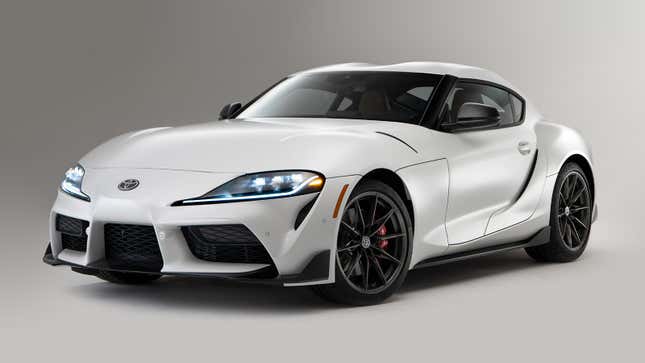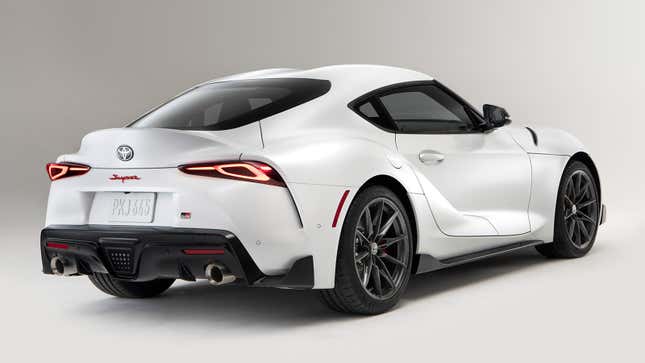The sun shined a little brighter when Toyota teased that the Supra was getting a manual transmission. The lack of a stick-shift disqualified Toyota’s halo sports car for many enthusiasts, and while it’s still a great machine, it always felt like something was missing. That changed Thursday, as Toyota finally confirmed that the manual Supra is real — for some buyers.
Update April 29, 2022, 4:20 p.m. ET: This story has been updated with new information about the origin of the Supra’s manual.
First, the good news. Toyota says it went to great lengths to engineer this transmission and make it play nice with the BMW-sourced 3.0-liter turbocharged inline-six. BMW doesn’t offer this engine with a manual, so Toyota had to do a lot of legwork to realize a manual Supra. Here’s what some of that entailed, from Toyota’s press release:
The engineering team modified an existing transmission housing, driveshaft and gear set and removed elements that were not required, such as the acoustic package, which reduced weight. At the heart of the transmission is a newly engineered large diameter clutch with a reinforced diaphragm spring. With a larger friction area and a stronger spring, this new component has the high-performance capability appropriate for use with the GR Supra’s high-torque engine.
The newly developed 6-speed manual gearbox also features an intelligent Manual Transmission (iMT) programmed with new software that prioritizes sporty performance. When upshifting, the parameters are tuned to optimize engine torque at the moment of clutch engagement and release; on downshifts, the software has been fine-tuned for consistent performance. The iMT is set as the default but, if the driver prefers, it can be switched off in Sport mode.
To avoid a sluggish take-off and a low in-gear acceleration feel, the final drive ratio has been shortened, from 3.15 (in the GR Supra automatic) to 3.46 (in the GR Supra MT). The result is response and gearing appropriate for sports car performance.

Following Toyota’s announcement, The Drive separately reported on Friday that the six-speed is, much like the Supra itself, of BMW origin. It’s a ZF unit “tuned by Toyota,” in so far as the Japanese automaker swapped out some parts for others — like the aforementioned large-diameter clutch, reinforced spring and the design of the shift knob:
“The parts used in the gearbox come from a combination of ZF manufactured manual transmissions, but the parts combination is exclusive to GR Supra,” a Toyota spokesperson told The Drive. “Toyota partnered with ZF and BMW on the design/layout of shift lever/pedal, decision of final gear ratio, tuning of iMT [rev-matching and upshift smoothing] function, and shift feel.”
This Supra-specific gearbox even gets its own, unique transmission code within BMW’s parts catalog: GS6L50TZ. For what it’s worth, the code for the manual found in the overseas and less powerful BMW Z4 sDrive20i happens to be GS6L40LZ, according to this SupraMKV forum post. Per BMW transmission designation rules, the difference between “L50T” and L40L” indicates a deviation in transmission “type” and gearset. The “GS6" and “Z” bits of the codes indicate a six-speed manual and ZF as the manufacturer, respectively. For further reference, the manual found in the current M3 and M4 is designated GS6-45BZ.
Speaking of the shift knob, Toyota says ergonomics were a consideration too. Making space for a manual in a car that wasn’t originally offered with one can be a bit of a bear. Again, from the manufacturer’s release:
Close attention was also paid to how a manual shifter could be accommodated in the driver’s cockpit. The lever ratio was specifically set to minimize the effort required to make shifts and engage reverse gear. While the weight and shape of the 200g gear knob, along with the quality of shift engagement, have all been precisely defined. Ergonomics were also top-of-mind, as the console unit and position of the drive mode selector were adjusted to provide a 1.7-inch clearance between the shift knob and the control panel.
Toyota didn’t announce pricing for the manual Supra. That news will come this fall, shortly before 2023 models hit showrooms.
Here’s the catch: this six-speed will not be offered on the 2.0-liter four-cylinder Supra in any capacity. Honestly, I don’t know if a manual could have saved that car; I don’t know if anything could salvage the lesser Supra when the GR 86 and now the long-awaited GR Corolla also exist in Toyota’s lineup. My colleague Steve believes that nobody would bother to buy a 2.0 Supra with a manual against those options, and he’s probably right.

To me, a manual 3.0 makes the 2.0 Supra an even worse proposition than it already was, a car that lives in the shadow of its big sibling. Perhaps it exists merely as a base for modifications, but how many 2.0 owners are doing 2JZ swaps anyway? I’m all for a cheap entryway to performance — especially for those skilled enough to make up the difference with wrenching — but the 2.0 is only about $8,000 less than the 3.0, and this is Toyota’s flagship. It should be a competent sports car in all its variants.
Toyota will also offer a limited-edition Supra with the manual equipped, called A91-MT. Only 500 of these will be built, with the requisite gearbox and an exclusive cognac interior for North America. Regardless of which model Supra you order, if you spec yours with a stick shift, you’ll get a red badge on the back, so everyone knows you bought the best Supra — and, perhaps, to twist the knife a little when someone pulls up in an earlier, auto-only Supra.